
Dr. Gerald R, Smith
Professor & TAMUS Regents Fellow
Email: g-smith@tamu.edu
Perennial warm-season grass pastures, primarily bermudagrass and bahiagrass, cover approximately 39 million acres in east Texas and the US southern region. These grasses support about 5 million cattle and are dormant from late fall until early spring. Cool-season forage legumes and grasses can be over-seeded in the fall as the perennial grasses become dormant, providing winter grazing and , in the case of legumes, nitrogen for the pasture system. Warm season legumes are also used in this region to provide supplemental forage and hay for livestock and browse for wildlife.
Forage legume and grass breeding programs have been in place at Overton for 40 years with the general objective to develop more reliable cultivars to co-exist in these perennial grassland systems. Our improvement programs have addressed such problems as:
-
- forage yield and seed production in annual ryegrass
- virus and fungal disease resistance in arrowleaf clover
- improved reseeding in crimson clover
- disease resistance and toxin removal in sweet clover
- seed production and nematode resistance in forage cowpea
- disease resistance in forage lablab bean
- persistence in white clover



Six forage legume cultivars developed at Overton are in commercial production in 2025. These cultivars are: Apache arrowleaf clover; Blackhawk arrowleaf clover; Silver River sweet clover; Neches white clover; Jade sweet clover (Australia) and Ace forage cowpea. Evaluation and seed increases are in progress on two additional cultivars that will be available in 2027.
In the last five years the average annual economic impact of these six cultivars was $16.4 million per year. This is calculated based on actual seed sales and validation data from research at Overton and includes only seed values, nitrogen contributions, value of calf gain and wildlife stewardship value. Contributions to soil and water conservation, soil carbon and soil health are not included in these impact value estimates.
